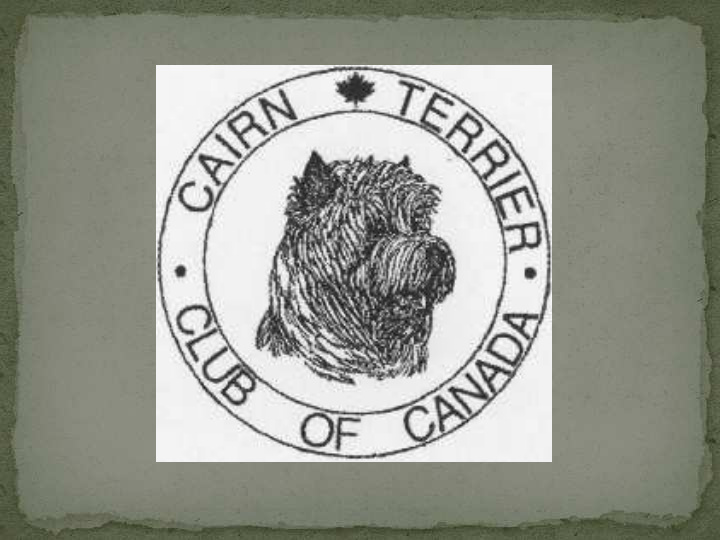



The Canadian Cairn Terrier Standard History The Cairn Terrier standard initially fell under the country of origin standard (U.K. Kennel club standard), when Cairns were first imported to Canada and the USA . 1921- the first Canadian and American standard came into existence 1925/1926- ideal weight revisions were made to the Canadian standard 1928/29- General Appearance “slightly changed.” 1933- Major changes were made to the American and Canadian standard, and for the first time diverged substantially from the country of origin. Ideal heights, weights, and proportions were added 2006- CKC adoption of The Kennel Club (UK) 1984 breed standard in Canada Notes The American standard has not changed materially since 1933. It is the only country in the world with a different standard for the Cairn Terrier , the rest of the world adopts the Country of Origin standard. The biggest difference between the standards is size and weight, with the AKC standard, smaller and lighter in weight.
The Cairn Terrier is an active, game, athletic, hardy and workmanlike terrier. Agile, alert of workmanlike, natural appearance. Standing well forward on forepaws. Strong quarters. Deep in rib, very free in movement. Weather-resistant coat.
Bred to work in the Rugged Western Highlands
Working a Cairn in the Western Highlands 1835
HEAD Skull Broad, decided indentation between the eyes, with definite stop. Muzzle powerful, jaw strong - not long or heavy
EARS: Small, pointed, well carried and erect, not too closely set. The ears are set high on the outer edge of the skull with the top 1/3 free of long hair EYES: Wide apart, medium in size, dark hazel. Slightly sunk with shaggy eyebrows. Note: Ears too close and eyes too close often mean the head is narrow
EXAMPLES OF GOOD CAIRN HEADS
SIZE AND PROPORTION The Cairn is a rectangular dog Prosternum to ischium = 1.5 X height at withers SIZE: 28-31 cm (11-12 ins) at the withers, but in proportion to weight . 6-7.5 kgs (14-16 lbs) ideally
This is a rectangular dog with sufficient length of back and leg to perform his original function. Back level of medium length Well sprung ribs, strong, supple, short loin Medium bone, compact strength and activity without heaviness Moderate angulation: Not extreme or exaggerated
1. Free showing Cairn balanced in front and rear, standing well over the frontlegs 2. No forechest, also stretched out behind, making the topline drop 3. The Cairn pulls up the underline due incorrect angulation in the rear, making the hindleg longer, and the dog looks high in rear
Ribs are well sprung, deep and heart shaped Depth of chest even with or slightly below the elbow Front legs are straight of medium bone, pastern slightly sloped. Feet may turn out slightly
Hindquarters very strong – well muscled thigh with rear projection beyond the tail set.
Length of tail = height of ears Tail is set high and on a level with the back May be carried from 12 – 2 o’clock
COAT: Very important , weather resistant, double coated, profuse, harsh but not coarse outer coat: undercoat short, soft, close. Slight wave is permissible.
groomed versus ungroomed
Color: Cream, wheaten, red, grey, or nearly black. Brindling in all these acceptable. Not solid black or white or black & tan. Dark points typical
Movement: Very free-flowing stride. Forelegs reaching well forward. Hind legs giving strong propulsion. Hocks neither too close nor too wide.
PUPPIES AND YOUTHS
CAIRNS IN ACTION
Recommend
More recommend